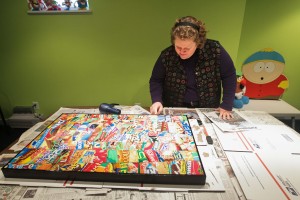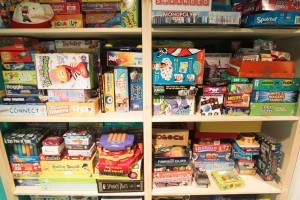No chutes, all ladders: One woman’s climb to the top of the board game industry
Lifestyle — By Lukas KeapprothIf there was a female version of Willy Wonka, that would be Peggy Brown. But instead of inventing candy, Brown brings the same whimsical attitude to creating board games.
It’s a comparison that begins with her home. Like Wonka’s factory, it’s a visual adventure. Walls are two-toned swirls of light yellow and sky blue, bouncy-balls serve as doorknobs, and a fake bookshelf stands in for a bathroom door.
“I guess I went a little crazy when I decorated in here,” Brown says while thumbing game pieces from one of her board games.
We eventually find ourselves in Brown’s workroom. The sea green walls are covered in hanging pliers and other tools neatly dangling on a corkboard and lined up by category, size and shape. Fluorescent lights cut across the corners of the room, casting a yellowish light.

Always creating, Peggy works on the top of a coffee table for her living room. The table is comprised of old cardboard cereal tops that rest under plexiglass. Photo by Lukas Keapproth
The workbench area is completely clear, save for a blue-handled wood saw sitting neatly in the middle of the table. An electrical box hangs just above it, covered in different stickers all choreographed in an abstract mess Jackson Pollack would envy.
The dining room is also simple, anchored by an electric blue table lit with subdued daylight streaming in through a window. Brown sits halfway on her chair, elbows firmly resting on the felt-like surface of the table — she says the surface makes playing games easier. She wears a burgundy vest with bluish swirls atop a long-sleeved shirt. Her brownish hair falls in curls, the bangs neatly parted to the side. Her chin fidgets in her hands before she quietly looks at me and asks, “So…what do you wanna know?”
With a career spanning 20 years, Brown has helped create hundreds of board games, working for big-name toy companies such as Mattel and Hasbro that have since marketed her games worldwide.
One game she’s known for is one of her first: “Pretty Pretty Princess.” The game, as most women remember, revolved around playing dress-up with an assortment of necklaces, earrings, bracelets and rings. The winner, of course, wins the crown. Brown handcrafted every part of the game, from the board to the jewelry.
“I remember when I had to market that game to Hasbro,” she says as a smile grows on her face. “I stood in a board room facing all these big men in nice suits, they were in these leather chairs and smoking — you know, when you could still actually do that. And then here I was trying to sell them on the idea of ‘Pretty Pretty Princess.’ Watching these guys passing around the game pieces and trying on the princess crowns was pretty amusing,” she says through laughter.

Peggy keeps a bookshelf full of samples from all the games she's worked on over the years. Many of those games, like Pretty Pretty Princess, have become iconic for children all over the country. Photo by Lukas Keapprot
Aside from the board rooms of huge corporations, Brown found herself surrounded by men throughout her college years. As an industrial design major in Milwaukee, she was the only female in her class. While she thinks things may have been easier with more women in her classes, she says she benefited from the gender disparity.
“I think it made me bold,” she says while crossing her arms and leaning on her elbows. “…It takes boldness to stand in a board room of a multibillion dollar company and share with these people your silly ideas.”
When Brown initially began her college career at the Milwaukee Institute of Art and Design, she planned on majoring in graphic design because of her love for drawing and painting. After taking a class in 3-D design, however, she was hooked on creating art that was interactive.
“The art became more than just looking at something on a 2-D surface,” she says. “Now I was dealing with people interacting with my work, and I always found it interesting to see how they used it.”
After graduating in 1988, she worked for a small game company for three years before starting her own toy-game business, Alley Oop, which consulted with companies for game ideas and design. She operated the company for eight years before closing it, but continues to work on a freelance basis with many other side projects. After 20 years, she isn’t running out of ideas anytime soon.
“My creative process?” She pauses to think and stops thumbing the game pieces before quietly placing them in the game box. “I play,” she says matter-of-factly. “No different than when I played as a kid. I think that’s the best way any — “
Tags: Board Games, Keapproth




 Digg This
Digg This Bookmark
Bookmark Stumble
Stumble